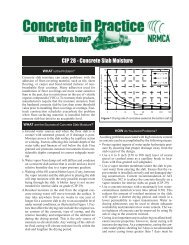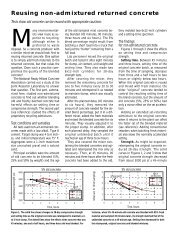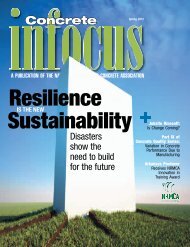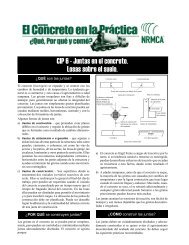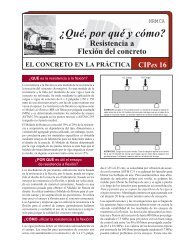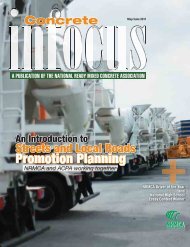Fall 2004 - National Ready Mixed Concrete Association
Fall 2004 - National Ready Mixed Concrete Association
Fall 2004 - National Ready Mixed Concrete Association
Create successful ePaper yourself
Turn your PDF publications into a flip-book with our unique Google optimized e-Paper software.
feature<br />
Cement Company purchased the Washington<br />
Cement Company and shut down its<br />
plant. Superior Cement then became the<br />
oldest cement plant operating in the state of<br />
Washington. The plant continued under the<br />
operation of Lone Star Cement until 1967<br />
and the business office remained in operation<br />
until 1973 when the plant formally<br />
shut down.<br />
But the story doesn’t stop there. It could<br />
be urban legend or just the historical pride<br />
of the town and the competitive nature of its<br />
workers. As the West was expanding, pioneers<br />
came to the Baker area in the late<br />
1800s and settled on the banks of the Baker<br />
River sometime around 1871. Washington<br />
didn’t become a state until 1889. In 1890,<br />
the town site was officially platted and businesses<br />
began to grow under the name of<br />
“Baker,” Wash. But across the river, the new<br />
Washington Portland Cement settlement<br />
grew up and became known as “Cement<br />
City.” It seems the town took on the personality<br />
and ownership of its favorite industry.<br />
Story has it “Star Cement” was a brand<br />
name of one of the cement companies and<br />
each town hailed from under each name,<br />
“Star City” and “Cement City.” In 1909,<br />
after much debate, the new community<br />
finally settled on the name of “<strong>Concrete</strong>.”<br />
In fact, as you walk along Main Street, a<br />
short section of town that still houses the<br />
original structures, it seems there was another<br />
reason why this little town took on the<br />
name of <strong>Concrete</strong>. In or before 1920, at<br />
least once and possibly twice, the town or<br />
parts of it burned down. And each time they<br />
rebuilt it, except the last time. They decided<br />
that rather than continue this self-imposed<br />
building boom they would build it differently.<br />
And they did — in concrete. The liquor<br />
store and bank each have signs today that<br />
indicate when they last rebuilt the structure,<br />
only this time for good and the structures<br />
still stand today.<br />
When you visit “<strong>Concrete</strong>” today,<br />
although the great limestone giants have<br />
12 ı FALL <strong>2004</strong>



